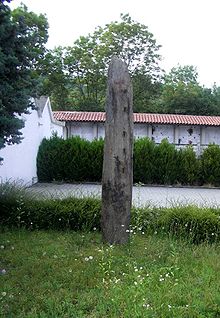Menhir by Lugnacco
The menhir of Lugnacco in Piedmont in Italy , discovered in 1975, is an irregular pillar with a square and triangular cross-section in its widest and thickest part. It was placed near the cemetery behind the apse of the old parish church of Lugnacco and dated to the Bronze Age. Its shape shows a connection to the phallic cult and fertility rites.
The frustoconical column has a circumference of about 1.2 m at the base and about 1.1 m near the top. The upper part of the menhir shows breakouts. The first of eight regular recesses is located 1.55 m above the ground, six of which measure approximately 6.0 × 4.0 cm while the other two are smaller. The stone is 384 cm long, the material is a garnet-mica-gneiss containing feldspar. Its calculated weight is 1,430 kg.
After a series of publications on the question of the authenticity of the find, it was forgotten until a second monolith similar to that of Lugnacco, which was used as a bench in Piazza d'Armi, was discovered in Chivasso in the late 1980s. Almost at the same time a third menhir was discovered during maintenance work along the tributary of the reservoir on the Dora Baltea near Mazzè.
According to local tradition, wrongdoers were chained to the Lugnacco menhir in the past.
In Italy, real menhirs can only be found in Apulia ( Menhirs from Zollino ), in Piedmont ( Stele from Mazzè ) and on Sardinia ( Pranu Muteddu ). There are also statue menhirs in Liguria , in Tuscany , in South Tyrol ( Algunder menhirs , statue menhirs from Latsch ) and on Sardinia.
literature
- A. Fassin, E. Gallo A., Ventosi: Tracce dell'uomo antico tra i massi coppellati del Canavese , Sopra e sotto terra 2, Bolognino editore 2001.
Web links
Coordinates: 45 ° 26 ′ 38.6 ″ N , 7 ° 46 ′ 40.9 ″ E
